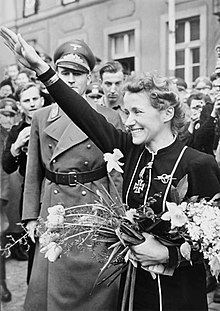Pilot and observer badges
The joint pilot and observer badge was donated on January 19, 1935 by Hermann Göring in his role as Reich Minister of Aviation as the successor to the aviation badge . The prerequisite for being awarded the joint pilot and observer badge was that the pilot or observer badge had already been awarded and that the requirements for both badges had been met. An ordinance of July 31, 1944 stipulated that at least one year had to elapse between the award of the pilot's or observer badge and the joint pilot and observer badge.
Appearance and wearing style
The badge is made of silver-plated tombac or fine zinc and was awarded until the end of the war. It is a high oval badge, the wreath of which is gold-plated and made of oak (right) and laurel leaves (left). The silver sovereign badge of the Luftwaffe of the second form is placed on the wreath. The back of the otherwise openwork badge shows a vertically soldered needle with a counter-hook. The award was worn as a pin badge on the left side of the chest under the Iron Cross 1st Class , if it was awarded . Embroidered variants of this badge were permitted for the pilot's outfit.
Gold with diamonds
The common pilot and observer badge in gold with diamonds occupies a special position among the other badges of the Luftwaffe. The diamond award was not officially donated, but introduced on March 16, 1935. It was therefore not a badge of activity, but saw itself as a gift of honor from Göring. The award was therefore made to residents and foreigners on an honorary basis.
The award criteria were:
- Services to the Air Force
- outstanding bravery
- exceptional achievements in troop leadership
- diplomatic agreement with foreign statesmen
Awards were made exclusively by Göring personally, and each honoree received two copies of the badge.
In the actual badge, the wreath is made of 14-carat gold and the eagle is made of platinum . The wings, the body and the swastika are set with diamonds. The second copy was made of gold-plated silver and set with rhinestones . A total of 60 awards were made and 34 awards can be verified. These goods:
- Heinrich Himmler on July 12, 1942
- Karl Dönitz on January 30, 1943
- Sepp Dietrich in autumn 1944
- Otto Skorzeny in autumn 1944
- Benito Mussolini on November 28, 1937
- Carl Gustaf Emil Mannerheim in early July 1942
- Ion Antonescu
- Italo Balbo
- Francisco Franco
- Walther Wever on November 11, 1935
- Erhard Milch on November 11, 1935
- Hugo Sperrle on November 19, 1937
- Werner Mölders in mid-August 1940
- Helmut Wick
- Adolf Galland in August 1940
- Ulrich Grauert
- Wolfram von Richthofen in August 1940
- Werner Baumbach in August 1940
- Kurt Student on September 2, 1940
- Friedrich Christiansen in September 1940
- Günther Korten 1940
- Alexander Lohr 1941
- Bernd von Brauchitsch in the summer of 1944
- Erich Hartmann on August 25, 1944
- Hans-Ulrich Rudel in the summer of 1944
- Robert Ritter von Greim on April 17, 1945
- Martin Harlinghausen on April 17, 1945
- Albert Kesselring
- Hans-Joachim Marseille
- Dietrich Peltz
- Bruno Loerzer
- Hanna Reitsch on March 27, 1941
- Melitta Schenk Countess von Stauffenberg in March 1943
Among the award winners are two women, Hanna Reitsch and Melitta Schenk Countess von Stauffenberg, who are test pilots . In addition to the decoration, they received a ladies' clasp specially made for them. The original piece by Ms. Hanna Reitsch is on display in the Zeppelin Museum in Friedrichshafen on her uniform and can be viewed there.
Others
According to the law on titles, medals and decorations of July 26, 1957, wearing the joint pilot and observer badge in the version of the Third Reich in the Federal Republic of Germany is only permitted without a swastika.
literature
- Heinrich Doehle : The awards of the Greater German Reich. Orders, decorations, badges. 5th edition, licensed edition. Patzwall, Norderstedt 2000, ISBN 3-931533-43-3 .
- Kurt-Gerhard Klietmann : Awards of the German Empire. 1936-1945. 11th edition. Motorbuch, Stuttgart 2004, ISBN 3-87943-689-4 .
- Hans-Ulrich Krantz: Orders and decorations of the Federal Republic of Germany. Maximilian, Cologne 1958.
- Jörg Nimmergut : German medals and decorations until 1945. Volume 4: Württemberg II – German Empire. Central Office for Scientific Order Studies, Munich 2001, ISBN 3-00-001396-2 .
Individual evidence
- ↑ Order of the Reich Minister of Aviation No. 3 of January 19, 1935
- ↑ LVBl. 7 August 1944, p. 543.
- ^ Jörg Nimmergut: German medals and decorations until 1945. Volume IV: Württemberg II - German Empire. Central Office for Scientific Order Studies, Munich 2001, ISBN 3-00-001396-2 , p. 2445.
- ↑ FLNeher: WICK. Hanns Arens Verlag, Berlin-Herrlingen 1943, p. 1.



